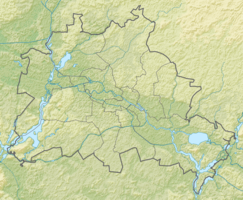Monbijoupark
| Monbijoupark | ||
|---|---|---|
| Park in Berlin | ||

|
||
| Park view | ||
| Basic data | ||
| place | Berlin | |
| District | center | |
| Created | 19th century as a park for Monbijou Castle | |
| Newly designed | 1960–1962 1974 and 2006 |
|
| Surrounding streets |
Oranienburger Strasse , Monbijoustrasse |
|
| use | ||
| User groups | Foot traffic ; Leisure , events | |
| Technical specifications | ||
| Parking area | 4 hectares | |
|
52 ° 31 '23 " N , 13 ° 23' 49" E
|
||
The Monbijoupark is in the Spandau suburb of Berlin-Mitte located four hectares large park . The protected green area is located in a popular nightlife and strolling area in Berlin-Mitte and is bordered by the Spree to the south, by Monbijoustraße to the west and by Oranienburger Straße and Monbijouplatz to the north .
history

Monbijou Castle stood on the site of the park until 1959, the remains of which, damaged by the war, were removed for political reasons. Large parts were preserved, but were removed in a similar way to the Berlin City Palace, because money for an elaborate reconstruction of an aristocratic palace was not provided in the GDR era.
The building was a pleasure palace in the middle of the city, built in a light Rococo style for Countess Wartenberg. After this fell out of favor, the crown prince couple lived in the building, which was a striking round gate building at the end of the 19th century. In the park stood the small English Georgs Church by Julius Raschdorff , a Gothic building made of red granite. During the imperial era, the palace was home to the Hohenzollern Museum, in which, among other things, the death chair of Friedrich Wilhelm I, the work table of Helmuth Karl Bernhard von Moltke and souvenirs of Queen Luise von Mecklenburg-Strelitz were exhibited. The park area was converted into an amusement park by 1962. This included the construction of a children's outdoor pool based on plans by Heinz Graffunder and Walter Hinkefuß in 1960. In 1974 the park was redesigned again, and a restaurant pavilion based on a design by Peter Hartlich was added. After the fall of the Wall in 2000, the bathroom and restaurant were extensively renovated. The restaurant pavilion was demolished during subsequent renovation and redesign work carried out throughout the park.

Cityscape
In the park is the preserved and renovated children 's outdoor pool, known as the Monbijou children's pool . The monument carved out of marble for Adelbert von Chamisso comes from Julius Moser (1888) and is a listed building .
With the address Monbijouplatz there are three buildings in the Berlin monument list (number 1, 2 and 4).
Redesign since 2006
From 2006 to 2007, the park was redesigned according to plans by garden and landscape architects Lützow 7 from Berlin for 3.3 million euros and a waterfront promenade up to nine meters wide was set up. Since then, the paths have led straight through the green area with its extensive lawns, which are expressly approved for sunbathing and ball games.
Also new is a bowl fountain in the tradition of the 18th century on Oranienburger Strasse at the corner of Monbijoustrasse by Jasper Halfmann, who stood in the Prinzessinnengarten between 1995 and 2000 in the German State Opera and the former Prinzessinnenpalais. At the suggestion of the residents, a toboggan hill was created for the winter and the former barbecue area has also been designated again. After removing the bushes, there is a clear view from Oranienburger Strasse under the treetops almost to the Spree.
The Monbijou Bridge , rebuilt in October 2006, connects the park with the Bode Museum and Museum Island .
An official Freeletics Training Ground was opened at Monbijoupark in October 2017 .
literature
- Folkwin Wendland: Berlin's gardens and parks from the founding of the city to the end of the nineteenth century; (Classic Berlin); Propylaea: Berlin 1979; Pp. 247-257; ISBN 3-549-06645-7 .
Web links
Individual evidence
- ↑ Monbijoupark , on stadtentwicklung.berlin.de, accessed on April 13, 2015.
- ↑ Monbijoupark, bust of Adalbert Chamisso, 1888 by Julius Moser.
- ↑ Freeletics in Monbijoupark , accessed on March 4, 2019.

